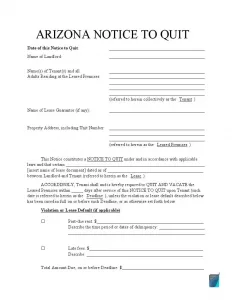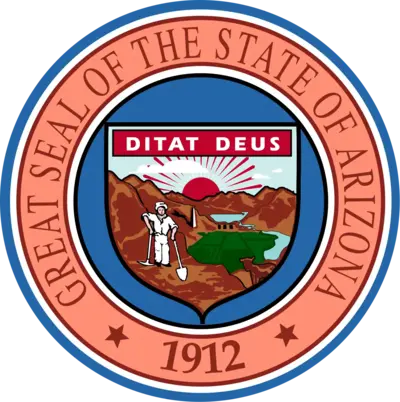Arizona Eviction Notice Forms
In Arizona, relations between the lessor and lessee are regulated by the legal documents which meet state laws on lease relations. An eviction notice is one of these documents, which is typically made by the landlord. If a tenant who lives in the landlord’s apartment does something that can be considered as a lease violation, the landlord has the right to give him or her a free eviction notice where the lessor claims if the tenant improves the situation or leaves the apartment immediately. This kind of decision is only up to the landlord’s will.
Reasons, why the landlord creates and grants eviction notices, are various starting with hiding the fact of a pet presence and finishing with the delayed payment of the rent.

Build Your Document
Answer a few simple questions to make your document in minutes
Save and Print
Save progress and finish on any device, download and print anytime
Sign and Use
Your valid, lawyer-approved document is ready
Arizona Eviction Laws
As it was already mentioned, all legal rental documents, including eviction notices, are obliged to follow the Arizona state laws. Otherwise, the eviction deal won’t be considered legal, meaning the tenant won’t leave the apartment. In a situation like this, the Arizona state laws will choose the resident’s side because the Arizona laws establish the lessor assists the lessee till the last day of their rental relations.
Basic information on the eviction process in the state of Arizona can be found in several legal documents, such as:
- Arizona Residential Landlord and Tenant Act;
- Arizona Code, Title 33 (Property), Chapter 9 — Condominiums;
- Arizona Statutes, Title 33 (Property), Chapter 16 — Planned Communities;
- Arizona Statutes, Title 33 (Property), Chapter 18 — Homeowner’s Association Dwelling Actions;
- Arizona Revised Statutes, Title 12 — Courts and Civil Proceedings.
They cover details of the eviction process, establish the time given to the resident for leaving the apartment, or improve the situation, which led to the creation of the eviction notice. Looking through these documents, you will also know about the way the holder has to receive the notice as leaving it under the door is not legal in Arizona.
Arizona Eviction Notice Laws Details
| Rent Grace Period | 5 days |
| Notice of Non-Payment | 5 days |
| Notice of Non-Compliance | 10 days |
| State Laws | Arizona Revised Statutes, Sections 33-1361 to 33-1378 |
Eviction Notice Types Used in Arizona
There are four types of eviction notices used in Arizona.
5-Day Notice for Non-Payment of Rent
This Arizona eviction notice meets the requirements of the ARS §33-361.
The notice is created and used in a situation when the tenant delays his payment for five days after the deadline mentioned in the rental agreement. If there’s still no payment within these five days, the landlord has a whole right to complete the form and deliver it to the resident. Receiving the notice, the resident has just five days to complete the payment. Otherwise, he must leave.
It’s essential that the owner delivers the eviction notice personally. At least he sends it by a confirmed correspondence. If he uses mail, the lessee has 10 days to pay rent.
10-Day Notice to Quit for Lease Violations
ARS §33-1368(A) regulates this eviction notice.
It’s used in any lease violations except the late payment and the unrecoverable damage. The tenant has 10 days to improve the situation, or he must move out of the habitation.
The violation date should be mentioned in the notice, same for the description of the disturbing situation. After this, the owner needs to pass the notice personally or to use the confirmed private post.
30-Day Notice to Quit for Month-to-Month Tenancies
This eviction notice is managed by the ARS §33-1375.
Receiving the notice, the renter understands he has 30 days to move out of the apartment. Though it doesn’t mean he violated the lease agreement in some way. The paper is made to warn the occupant about the lease termination in 30 days.
A Certificate of Service is one more document used in addition to the 30-Day eviction notice. A person doing the service signs the document and, after that, delivers it to the second party of the lease agreement. He has to do it personally or use confirmed mail.
A Notice of Irreparable Breach
This notice, regulated by the ARS §33-1368(A), perhaps, leads to the most serious consequences. Receiving it means the tenant has to leave the apartment at once. He has no right to improve the situation, which has led to this note being completed.
The tenant might receive this eviction notice if the landlord finds out the tenant was involved in such illegal activities as gang activity, prostitution, dealing drugs, or creating situations that might have a negative effect on the health of the landlord or his family.

Eviction Process in Arizona
For completing the eviction process in the state of Arizona, a special procedure must be followed. Everything must be done according to the laws of the state regulating rental relations.
While completing the eviction process, follow the instructions to make sure you’re doing everything the way it should be done.
- Bring the Completed Notice to the Tenant
If you’re the landlord and understand there’s some kind of lease violation by the tenant, you may complete the eviction notice. You can do it yourself, or you can use our form-building software to save your time.
Fill in the name of the tenant, his or her address, information on the lease violation (depending on the eviction notice form), date of completing the form, and leave your signature.
After this, deliver the notice to the renter personally or by the confirmed mail service.
- Apply to the Court
Another step is to lodge a complaint to the court. Please note that there is a charge of $35 you have to pay to apply for the Justice Court and $218 to apply for the Superior Court in Arizona.
The landowner needs to issue a summons on the day of paying fees and applying for the court. He can do it only via a certified process server not more than two days before the hearing in the court.
- Wait for the Court Judgment
The eviction hearing typically happens after three to six days after issuing the summons.
The resident needs to come to the hearing. Oppositely, the judge will take the landlord’s side by default. If the resident comes to the court, he or she can file an appeal complaint and direct it to the judge. He has only five days to do that.
If the judge decides the truth is on the lessor’s side, he might issue the writ of restitution, meaning the lessee must leave the apartment immediately without further discussion and additional time provided.
Arizona Eviction Court Forms
While applying to the court, you will need to complete several legal documents.
- A Complaint Form
In the form, the owner can describe all his complaints in relation to the resident. If there’s a criminal element in the late payment of the rent, then the order for eviction must be completed.
- Writ of Restitution
It is the final notice saying that the possessor must leave the apartment immediately.
- Summons Form
The owner completes the form on the same day as a complaint form. The main difference between these two forms is that a summons states the fact of a lawsuit, while the complaint form shows the lessor’s personal offense and how big the loss is.

We provide an array of popular Arizona forms to anyone in quest of simplicity when handling various papers in the state.
Other Eviction Notice Forms by State
